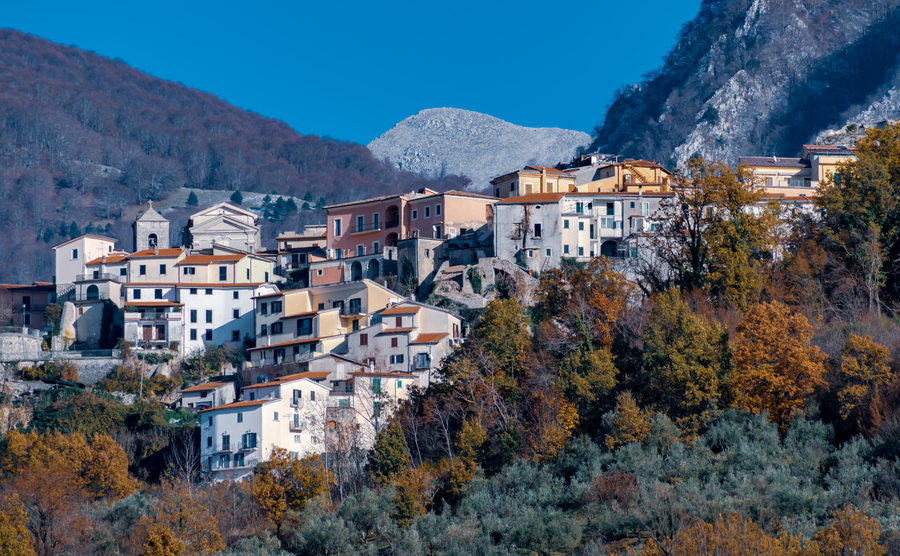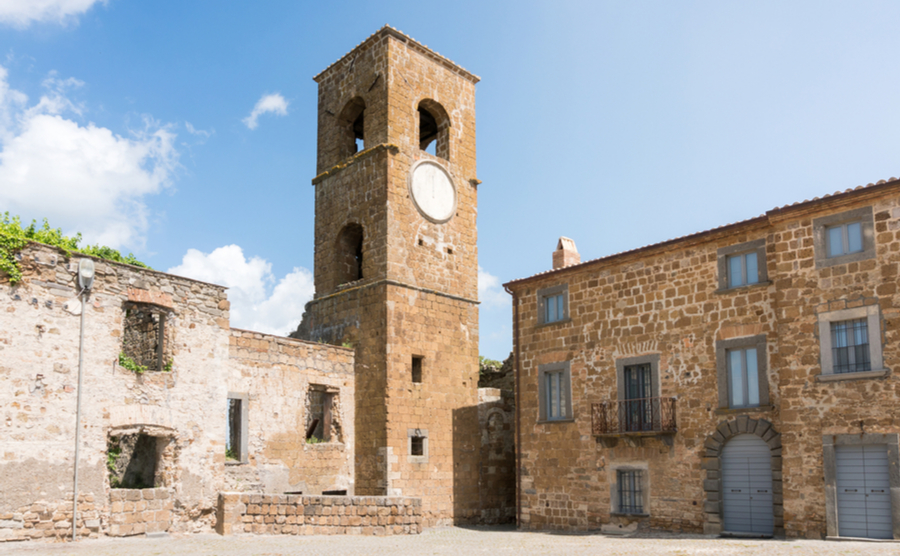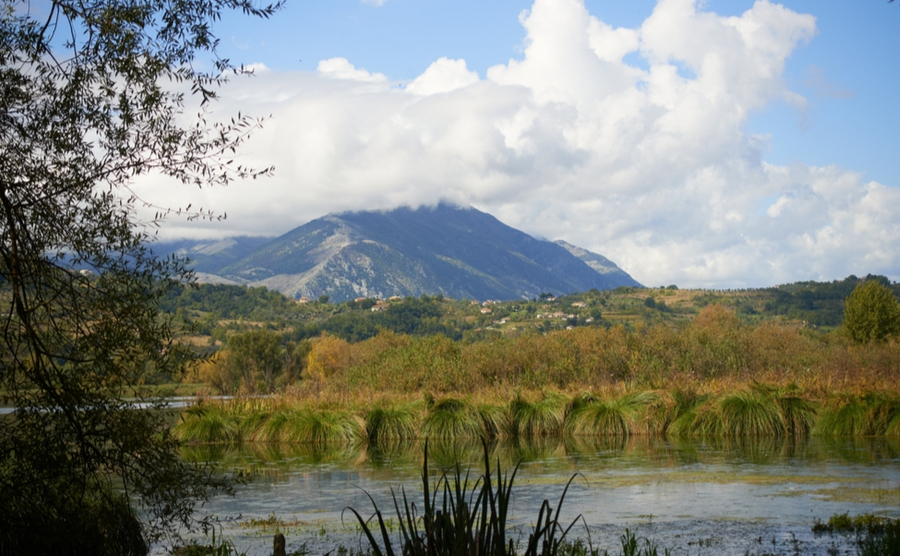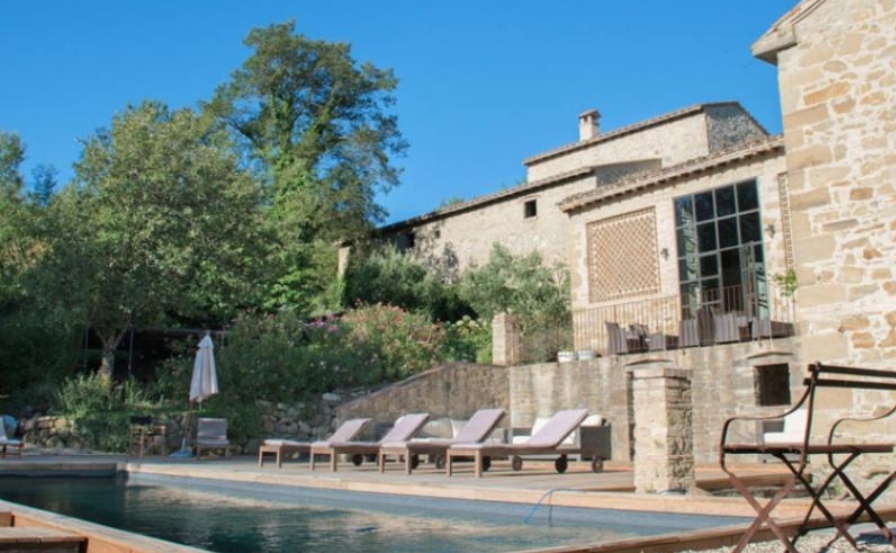Many of us dream of owning a village house in Italy. But what if you discover the village once lived in by your ancestors is now abandoned and going to ruin, would you try to save it?
Cesidio Di Ciacca, a Scottish lawyer and entrepreneur did just that. Fascinated by his family history and the place in Italy where his ancestors once lived, he would visit the area several times over the years. And so, his love of the place of childhood holidays, grew into a dream of one day restoring the old family home. But not just the one house. As the whole village had been abandoned and was going to ruin, the idea developed into a mission to renovate every part of the village of Ciacca.

Unfortunately we don’t have images of Ciacca, this is the nearby village of Picinisco under Mount Meta
Locating the owners of the village houses
In order to restore a whole village, Cesidio would first have to own all the buildings. The first step was to track down the 140 owners, from eleven families. Many of these families had also emigrated abroad over the years, making the process of locating them even more difficult.
With a search of catastale records (land registry), and the help of relatives and others in the area that had kept in contact with people that had moved away, he managed to gather contact details. As the buildings and land had never been sold out of the family it only took about a year to find all of the owners.
Over a three-year period, he was able to gradually proceed with the legalities and property purchases. Not an easy task when land and buildings had been divided up between a number of family members.
Buying property with multiple owners
It’s quite common in Italy, to find houses and plots of land that have been inherited by several family members. In order to sell the property each one has to give their approval for the sale. That’s why it’s essential that potential buyers check who legally owns the property at the earliest stage, and that every owner agrees to the sale.
When you consider that these are often inherited properties, that have been handed down through the generations, it is understandable that in some cases a family member might not agree to sell. They will have memories of visiting grandparents there and may want to keep the property for sentimental reasons.

Abandoned village houses in Italy I Image credit: starmaro via Shutterstock
The abandoned village of Ciacca
The village or hamlet that was once home to around 70 people is where Cesidio Di Ciacca’s father, was born. In 1920 his parents, Cesidio and Marietta Di Ciacca, decided to start a new life in East Lothian, Scotland. They opened a café which sold fish, chips and ice cream. Gradually, more people left the village or died, and by 1969, there was no one left. In fact, many people from the area followed the Di Ciacca family to Scotland.
Family History
With more people taking an interest in their family history and discovering Italian ancestry through DNA tests, the next step for many is to visit these places. How amazing must it feel to walk where your great grandparents once walked, looking at the same views and enjoy food and wine produced in the area for centuries.
The history of a house
Even if you have no family connection to the old property you decide to buy, elderly locals will soon tell you stories about the previous owners and how they lived. It’s fascinating to hear how they used to cook on the fire and hang tomatoes from the nails in the ceiling.
The family history of a house is what gives it that warm homely feel. When you see an abandoned house, it can trigger an instant desire to put life back into it. While it can end up costing you more than your initial budget, to renovate an old house is certainly a very rewarding experience.
What the family have done at “I Ciacca”, should be an inspiration to anyone thinking about reconnecting to their origins and buying a property in the region of their ancestors. By employing local people and buying local products you will also be contributing to the local economy and could help save a community.
Find homes in Italy via our property portal.

Lake Posta Fibreno, Ciociaria
Where is Borgo Di Ciacca?
The small rural village of Ciacca (Borgo Di Ciacca in Italian), lies between Rome and Naples in an area called Ciociaria. It is located in the Municipality of Picinisco, in the province of Frosinone. Picinisco is on the Lazio side of the Abruzzo National Park, where you can breathe fresh mountain air and see monasteries and churches. It is partly the beautiful, rugged landscape of Ciociaria that makes the Scots feel at home here and vice versa.
Italians in Scotland
A recent Italian voter census estimated that there are 70,000 to 100,000 people in Scotland of Italian descent or are Italian nationals, which is up to 1.9% of the overall Scottish population. Latest available figures from the 2011 UK Census show there were 6,048 people born in Italy living in Scotland.
Famous people with family from Frosinone
Many people from the villages around Borgo De Ciacca moved to Scotland. Actor Peter Capaldi, most well known for playing Doctor Who, has family links to Picinisco on his father’s side. As does singer-song writer Lewis Capaldi. Other famous names with family links to the area include Francis Rossi of Status Quo and late hotelier Lord Charles Forte. Whose granddaughter is the UK TV personality Alex Polizzi, better known as “The Hotel Inspector”.
The renovation of Borgo di Ciacca
When your village is located on a hill, there is a lot to consider regarding getting energy, internet and water to the properties. You also need road access to transport building supplies and good local tradespeople. Where possible local people were employed in the renovation of the Borgo Di Ciacca. Therefore, bringing employment to the area from the start.
According to Studio DNA the renovation project for Borgo Di Ciacca won the Ursa Award in 2015. It was celebrated as the best sustainable and energy redevelopment project of an ancient rural village. They preserved as much of the original buildings as they could and reused the old stone and tiles.
The aim was to combine the traditional architecture with technological innovation to provide energy and water. Wi-Fi is distributed throughout the buildings by a cell phone provider. To make the buildings more energy efficient and waterproof, modern insulation and vapor barriers were used.
Making an income in an Italian village
The main reason villages become abandoned is because the young people can’t see how they can make a living there, and so leave to get qualifications and find employment. However, investment from individuals, businesses, the state and local authorities, alongside the promotion of tourism and incentives to buy and renovate old properties, have begun to create work opportunities.
It’s wonderful to see young people who had gone away to gain qualifications and work experience abroad, now bringing back their expertise to run businesses, such as holiday accommodation, restaurants, arts and crafts, and vineyards.
The village paying its way
“I Ciacca” partly creates an income from offering hotel accommodation and deluxe suites. The hotel is called Sotto Le Stelle and is laid out in the style of an “Albergo Diffuso”, scattered around the village. They also have a small cultural centre, conference room, library, wine shop and space for cooking lessons.
But there are lots of other things going on too. Cesidio’s daughter Sofia left her company job in the UK to run the vineyard and they also produce honey, jam, and extra virgin olive oil from the land Cesidio bought near the village.
Why the British move to Italy
In 2021, the British embassy in Rome carried out a survey, to better understand the British population in Italy. Of those that took part, most Britons had settled in Italy to work (34%), while 27% had chosen to retire in Italy. An interesting result was that 29% indicated that they had moved to Italy to be with their families.
Family reunification visa
Since Brexit, British citizens hoping to move to Italy have had to apply for a visa. One option is the family reunification visa. This allows entry into Italy to a spouse, civil partner, child under 18, dependent child due to health conditions, or dependant parents. You can find more information on the London “Consolato Generale d’Italia” website.
Dual Citizenship by decent
In Italy family is very important and so it’s not surprising that the application process for dual citizenship by descent is fairly straightforward with a law called “jure sanguinis” (right of blood). Any individual with a close relative such as a parent, grandparent, or great grandparent can apply.
Dual citizenship is a popular option as it enables individuals to work and live in Italy, and indeed all across the EU. In addition, Italian citizens have full access to healthcare and educational benefits. To apply you need to prove with documentation that you have legitimate ancestral ties.
Advice from Cesidio Di Ciacca…
When I asked if Cesidio had any advice for anyone buying a village house needing renovation he said “Do all your research, pricing and decision making with the best professionals you can find. If you are uncertain don’t start.”
Village homes for sale
For €85,000 you could own a two-bedroom house in a charming hamlet called Fabro in Umbria. The village has a castle, and beautiful countryside views. View the property on Your Overseas Home
If owning a small hamlet in Italy appeals to you, but you don’t want to have to spend the time renovating it, then take a look at this stone hamlet for sale in Tuscany. Made up of a large main building, a professionally equipped restaurant, swimming pool, and 6 charming apartments, with a total of 13 bedrooms and 12 bathrooms, it has been beautifully converted into a B&B.
Near Bagni di Lucca, Tuscany, you can find this village stone house for sale for just €50,000. It needs some renovation to bring it up to date, but it has some great original features such a fireplace, terracotta brick flooring and wooden beams. View on Your Overseas Home













